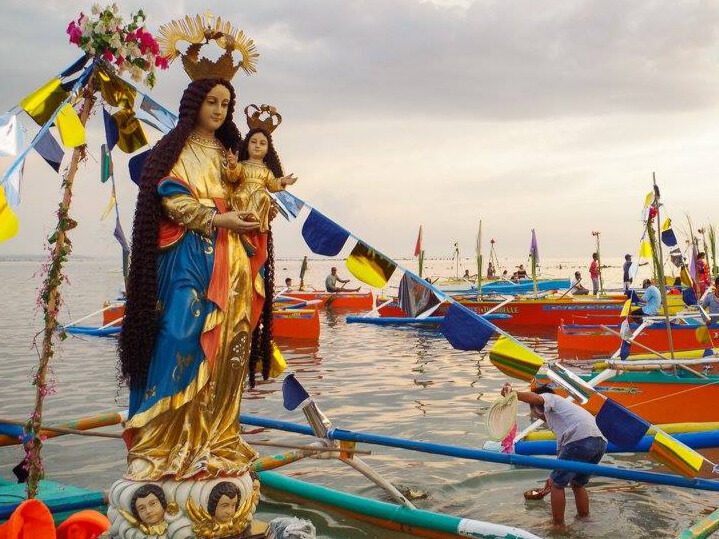SUMMARY
This is AI generated summarization, which may have errors. For context, always refer to the full article.

MANILA, Philippines – From the shores of Japan in 1620 as the legend goes, the fabled image of Our Lady of Badoc is now in Milan.
Laoag Bishop Renato Mayugba brought a replica of the 400-year-old image of La Virgen Milagrosa de Badoc, also known as Apo Badoc, to this Italian city on Sunday, February 10.
Apo Badoc is the patroness of Ilocos Norte, a northern Philippine province of more than 609,500 people. It boasts of historical churches, including a UNESCO World Heritage site, and is the birthplace of President Ferdinand Marcos Jr.
Before being flown to Milan, Apo Badoc had already been brought to the German city of Heilbronn, Rome, and Copenhagen, according to the news service of the Catholic Bishops’ Conference of the Philippines. It was also Mayugba, 68, bishop of Laoag for more than a decade, who brought Apo Badoc to Germany, Denmark, and Italy over the past five years.
In bringing the Ilocano icon to different churches worldwide, the Catholic Church aims to strengthen the faith of overseas Filipinos, who brave foreign lands to provide for their families back home. They are also the ones who fill church pews in countries where they work, as Catholicism declines in places like Europe.
‘Smugglers of the faith’
“Kahit saan pumunta ang Pilipino, dala niya ang kanyang debosyon (Wherever Filipinos go, they bring their devotion),” Mayugba said in his homily in Milan on Sunday. “Tayo ngayon ang mga bagong mga missionaries (We are now the new missionaries).”
Pope Francis had said in December 2019, when he led the first Simbang Gabi at Saint Peter’s Basilica in Vatican City, that Filipinos are “smugglers of the faith” – alluding to how overseas Filipinos “smuggle” their faith even to places where it is dangerous to be Catholic, such as the Middle East.
When he was studying in Rome, said Mayugba, he heard the story of an Italian boy who surprised his parish priest when he recited the Our Father in Filipino. “The priest said, ‘Why do you pray like that?’ ‘Because my yaya taught me,’ (the boy) said.”
Mayugba told the Filipino Catholics in Milan: “Combined with your work, you are bringing the faith to the people you live with. May the Lord bless you – for your work and mission as Filipinos and Christians in this part of the world.”
Among the Philippines’ 17 regions, the Ilocos Region – which is composed of Ilocos Norte, Ilocos Sur, La Union, and Pangasinan – was the fifth largest source of overseas Filipino workers (OFWs), according to the Philippine Statistics Authority’s (PSA) 2022 Survey on Overseas Filipinos. The Ilocos Region contributed 9.1% of the 1.96 million OFWs during the period April to September 2022.
Up to 9% of OFWs worked in Europe. Italy is one of the top destinations as domestic helpers – to the point that a Filipino film producer, ABS-CBN’s Star Cinema, even produced a 2004 movie titled Milan.
‘Shipped out of Japan’ in 1620
Toward the end of his Mass in Milan, Mayugba said he is leaving with them the miraculous image of Our Lady of Badoc, who is known to help bring peace to families. “Ang kanyang gusto ay buuin ang pamilya (What she wants is to keep families together),” the Laoag bishop said.
The original image of Our Lady of Badoc is enshrined at the Minor Basilica of Saint John the Baptist in Badoc, Ilocos Norte.
The designation of “minor basilica” is significant because there are only 22 minor basilicas out of thousands of Catholic churches in the Philippines, while the world’s four major basilicas can only be found in Rome, the seat of the Pope. This means the shrine of Our Lady of Badoc is one of the 22 most exalted Catholic churches in the Philippines.
According to Museo Ilocos Norte, the image of Apo Badoc was said to have been found by local fishermen in 1620 – contained in a wooden crate floating off the shores of Lago, Dadalaquiten, on the border of Badoc, Ilocos Norte, and Sinait, Ilocos Sur. In another crate was the image of Santo Cristo Milagroso, an image of a dark-skinned crucified Christ, which is now honored in Sinait.
Apo Badoc and Santo Cristo Milagroso are believed to have been shipped out of Japan by persecuted Christians in the 17th century, said Cardinal Orlando Quevedo, a longtime bishop in Mindanao but a native of Laoag, Ilocos Norte.
This kept the images away from destruction as the Tokugawa Shogunate prohibited Christianity and ordered the persecution of Christians in the early 17th century. One of those martyred in Japan was the first Filipino saint, Lorenzo Ruiz of Binondo, Manila, who died of torture on September 29, 1637, for refusing to renounce his Catholic faith.
In 2019, four centuries after it was found, Mayugba also brought Apo Badoc to Japan. – Rappler.com
Add a comment
How does this make you feel?
![[The Wide Shot] Peace be with China](https://www.rappler.com/tachyon/2024/07/wideshot-wps-catholic-church.jpg?resize=257%2C257&crop=311px%2C0px%2C720px%2C720px)
![[OPINION] A critique of the CBCP pastoral statement on divorce](https://www.rappler.com/tachyon/2024/07/TL-cbcp-divorce-statement-july-19-2024.jpg?resize=257%2C257&crop=285px%2C0px%2C722px%2C720px)


![[The Wide Shot] Was CBCP ‘weak’ in its statement on the divorce bill?](https://www.rappler.com/tachyon/2024/07/cbcp-divorce-weak-statement.jpg?resize=257%2C257&crop=258px%2C0px%2C719px%2C720px)





There are no comments yet. Add your comment to start the conversation.